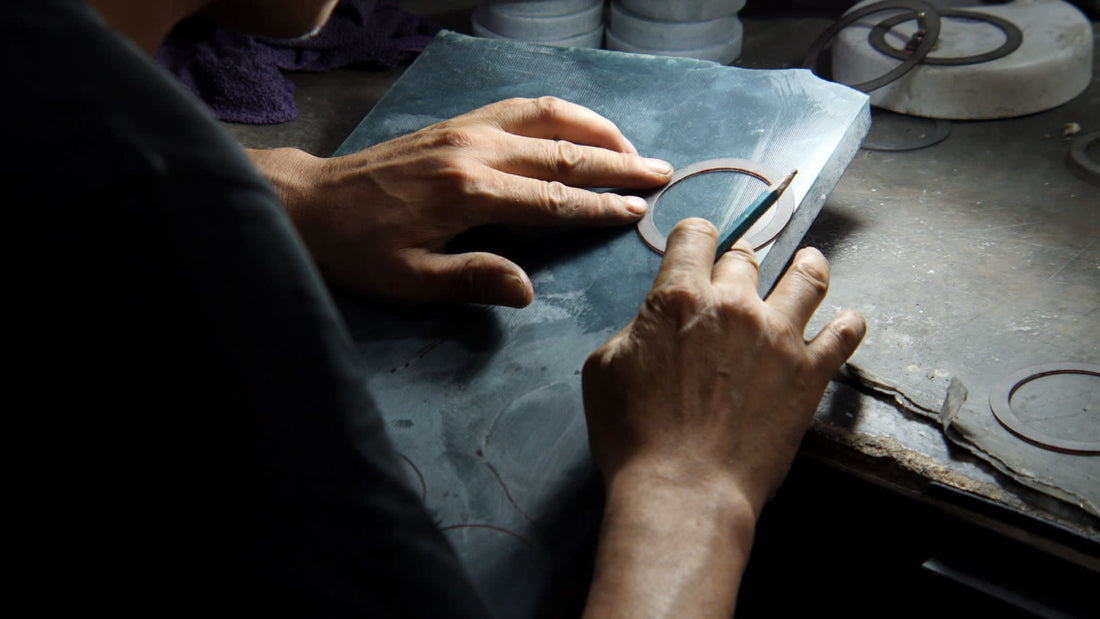
Carving a Jadeite Bangle
Share
Selecting the Jadeite Boulder
The initial phase of crafting jadeite bangles involves a critical selection process of the raw material—the jadeite boulder. These boulders are typically acquired through government auctions or from local vendors who specialize in selling these precious gemstones. The boulders are often covered by an outer layer that varies in color from brownish to black, obscuring the potential quality of the material within. Some boulders might exhibit small "windows" or sections where the outer layer has been ground down, offering a glimpse of the interior quality. However, in many cases, these boulders present an enigmatic challenge as their inner composition remains hidden, and determining the presence of high-quality jadeite within becomes a combination of luck and skilled assessment.

Slicing the Jadeite Boulder
Once a suitable boulder is chosen, the process proceeds to slicing the jadeite. This involves using large diamond-coated blades, which are continuously drenched in water. The water serves a dual purpose: acting as a lubricant to facilitate smoother cutting and as a coolant to prevent overheating of both the blades and the jadeite material. Each slice reveals a section of the boulder's interior, offering a chance to assess for potential high-quality veins or areas of interest. These slices are carefully examined after each cut, as the appearance of valuable jadeite within the boulder dictates further actions in the crafting process.

Perfect Placement for Bangle Creation
Following the slicing process, the jadeite is transformed into manageable slabs. Skilled workers meticulously draw outlines of bangles on these slabs, considering several critical factors: size, flaws, and wastage. Maximizing the number of bangles while minimizing flaws and reducing material wastage is paramount at this stage. Achieving the perfect balance among these considerations requires expertise and precision.

Sizing Considerations
In the creation of jadeite bangles, common sizes typically range from 52mm to 59mm, dictated by the characteristics of the slabs. However, sizes beyond this standard range are not uncommon and may require customized setups for carving and polishing. The decision regarding the final size of each bangle is influenced by factors that maximize the value and aesthetic appeal of the finished product.

Managing Natural Flaws
Natural flaws within the jadeite material are common and pose a challenge in determining the placement of bangle templates on the slabs. This phase requires a delicate compromise between maintaining the quality of the bangles and optimizing their overall value. Significant flaws in critical positions can lead to breakage during subsequent drilling and polishing processes, emphasizing the importance of strategic placement.

Drilling Process
With the outlines drawn, the jadeite slabs are securely fixed inside a specialized drilling machine equipped with double-bladed, diamond-coated hole saws. The drilling process itself occurs underwater, a crucial technique employed to dissipate heat generated during drilling, reducing the risk of breakage in the jadeite material.
Shaping into Desired Styles
Following the drilling process, the rough bangles take shape through hand-carving techniques. Skilled artisans utilize tough-gritted diamond flat laps, which are essentially two halves of a flat lap made of diamond material, to meticulously shape the rough bangles into desired styles. This process is conducted while the bangle is mounted on a spinning spindle, requiring precision and expertise to achieve the intended design.

Polishing Techniques
Once the desired styles are carved, the jade bangles undergo their final polishing stage. This stage often involves the traditional method that has been employed for centuries—using bamboo to polish the jadeite. This ancient technique not only ensures a refined and exquisite finish but also serves to preserve the inherent luster and beauty of the jade. Subsequently, the polished jade bangles are thoroughly rinsed with water to eliminate any residue from the abrasive materials used in the polishing process. Finally, a coat of wax is applied to the bangles, enhancing and safeguarding their lustrous appearance.

Crafting jadeite bangles is a meticulous and intricate process that demands a fusion of skill, precision, and reverence for tradition. Each stage, from the initial selection of the raw boulder to the meticulous carving and final polishing, underscores the craftsmanship and artistry required to transform a rugged stone into a prized adornment. The entire journey encapsulates the timeless elegance and allure of jade, embodying not just a piece of jewelry but a symbol of sophistication and beauty that has captivated cultures across centuries.

3 comments
I love all the Jade bangles that you have brought to western market. My only gripe is with the sizing. It appears to be more geared to the very slender wrists of the Eastern ladies rather than that of the Western ladies. Some of us need bangles with an inner diameter of at least 78 mm.
Hello Dave, just read the process of carving bangles, fascinating. A question, I wear 5 bangles continuously and never remove them, will they require re waxing at some point because they’re worn every day?
Fabulous jade offerings Daves